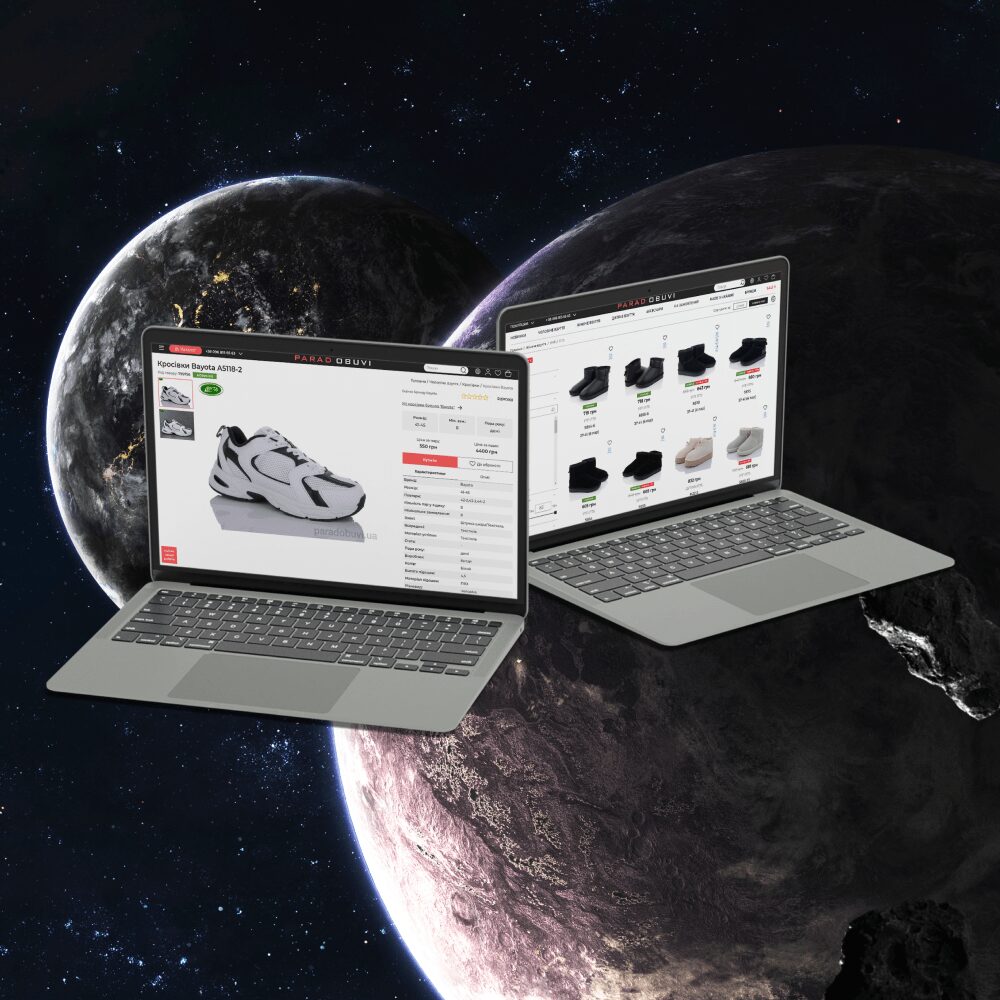Trends in e-commerce for 2025
Trends in e-commerce for 2025
Top trends and tendencies in eCommerceTrends in e-commerce for 2025 Top trends and tendencies in eCommerce
In recent years, e-commerce has been undergoing major changes due to the rapid development of technology. According to Forbes, 78% of companies in this industry are already using or planning to implement artificial intelligence, and according to ARtillery Intelligence research, 15-20% of online stores are actively integrating augmented and virtual reality (AR/VR) technologies into their processes. These trends promise to take the lead in 2025, significantly transforming the interaction between businesses and shoppers. Forecasts confirm that AI will become a key growth driver in e-commerce: it is estimated that the AI-enabled e-commerce market will reach $16.8 billion by 2030, demonstrating a compound annual growth rate (CAGR) of 15.7% from 2024 to 2032.
However, technology is only part of the future changes. It is important for online retailers to consider other significant trends, such as the eco-trend, the growing popularity of subscription-based sales, especially in the US, and the increasing number of payment methods.
These factors demonstrate that successfully adapting to change requires businesses to innovate and be flexible in their approach to customer preferences. We therefore offer a closer look at what the near future holds for the industry.

Artificial Intelligence in online stores
AI in eCommerceArtificial Intelligence in online stores AI in eCommerce
Top online retailers such as Amazon, eBay, Alibaba and many others – are already actively using artificial intelligence technology. For example, in Amazon, AI algorithms analyze the user behavior of each visitor and offer them personal recommendations, and Alibaba has introduced “online fitting rooms” based on computer vision (CV), which completely replace showrooms and help customers decide on their choice.
Digging deeper, there are dozens of ways AI can be applied to e-commerce. Here are the main ones:
- Personalizing the shopping experience. The system analyzes each customer’s behavior, including browsing history, purchases, and preferences, to offer exactly the products and services that are most relevant to their interests. For example, algorithms can generate recommendations based on previous purchases or the behavior of users with similar tastes, increasing the likelihood of a successful sale. AI can also tailor ads to a customer’s geolocation, create personalized newsletters, and more. According to Barilliance research, this approach can increase online marketplaces’ revenue by 31% or more.
- Data analytics and demand management. AI analyzes customer feedback, product browsing time, sales history, seasonal fluctuations and other events, helping stores more accurately predict trends and avoid overstock or shortages. This improves inventory management and allows for timely assortment adjustments to meet current customer needs. In addition, artificial intelligence helps optimize logistics, which reduces delivery times and improves customer experience.
- Customer service automation. The most popular and in-demand solution in this context is chatbots based on artificial intelligence.
Gartner predicts that by 2026, AI adoption will reduce customer service costs by 20-30%, and researchers from Servion Global Solutions are convinced that AI algorithms will handle up to 95% of customer interactions in e-commerce as early as 2025.
- Analyzing CA and selecting marketing strategies. Artificial intelligence effectively segments audiences by various parameters such as age, gender, geolocation, and interests. For each group, it can predict behavior and select the most effective marketing tools. For example, Instagram or TikTok ads will suit one group of customers and contextual advertising will suit another. This makes targeting more accurate and increases the return on marketing campaigns.
- Preventing fraudulent activity. Ensuring cybersecurity is especially important in the context of financial transactions, which are an integral part of any online store. According to Juniper Research, AI adoption as a whole will reduce business losses by more than $1 trillion and prevent up to 40% of fraudulent activities. At the same time, the average annual growth rate of AI use in cybersecurity will reach 23.6% by 2025.
- Improved product visualization. The use of artificial intelligence helps brands significantly save resources on visual content creation. Instead of expensive and time-consuming photo shoots, companies can generate detailed 3D models and product animations using AI. This not only speeds up the process of bringing new products to market, but also allows them to offer customers better and more interactive visualizations. For example, Levi’s has begun using AI-powered virtual models to showcase a greater variety of its products.

Key areas of AI for eCommerce
Types of artificial intelligenceKey areas of AI for eCommerce Types of artificial intelligence
There are different types of artificial intelligence that are used in one way or another in different business sectors. If we talk specifically about e-commerce, the most popular and in-demand areas of AI are:
- Computer Vision (CV). The technology allows artificial intelligence to recognize and analyze visual information such as photos and videos. CV can be used both in customer service – for example, to search for products based on an uploaded image or create a virtual fitting room – and in warehouse logistics – to analyze product balances.
- Natural Language Understanding (NLU). This technology enables AI to better understand customer queries, provide accurate answers, and analyze textual information.
For example, NLU algorithms are used in chatbots to communicate with users and analyze comments and feedback so that businesses can improve their products and services in a timely manner.
- Virtual agents and conversational interfaces. Such tools help customers at all stages of interaction with an online store: from selecting products to placing an order. Virtual agents provide fast and accurate support, improving user experience and increasing customer loyalty.
- Deep learning. The ability to learn quickly allows artificial intelligence to make more accurate, data-driven predictions and provide visitors with accurate and relevant recommendations.

Augmented Reality (AR) technology for online stores
AR in e-commerceAugmented Reality (AR) technology for online stores AR in e-commerce
While augmented reality technology was more often used for entertainment in 2023-2024, next year it could become one of the main growth drivers for the e-commerce industry. Researchers from Deloitte Digital and Snap Inc conducted a survey among customers of online stores and concluded that by 2025, more than 4.3 billion of them intend to use AR for online purchases, as this technology allows to better imagine how goods will look or function in real life.
If we compare augmented reality with virtual reality (VR), it is much easier and faster to integrate into eCommerce, plus users do not need additional expensive gadgets to use it – an ordinary camera on the client’s smartphone is enough. Thanks to this, AR is already actively used by many major players such as Alibaba, Nike, IKEA and others. Having studied their experience, we can highlight several main options for implementing augmented reality in eCommerce:
Virtual “fitting room”. Allows customers to try the product “for themselves” before buying. For example, customers can see how glasses, shoes, cosmetics or various accessories will look on them without leaving home. This is especially useful for reducing return rates and increasing confidence in the purchase. This AR-based feature is used by many brands, such as the same Amazon, Ray Ban and Warby Parker.
Visualization of furniture and interior items. Used to visualize furniture and other interior items in real space. For example, a customer can choose the desired cabinet, point the smartphone camera at his room and see how it will fit into the interior of his apartment. IKEA store offers such an option today.
Interactive marketing for offline stores. AR allows brands to create interactive content available to customers through their smartphone cameras.
For example, it can be animations that come to life or narrative stories that tell about product features, usage or brand philosophy. The technology works by superimposing digital content on real-world images in real time, which makes the process of interacting with the brand exciting and memorable. This is a concept that Nike has successfully implemented in its Play New AR app.
Step-by-step instructions with visuals. AR helps to create detailed and visual instructions for assembling furniture, setting up complex devices or using cosmetics. Such guides can include 3D models, voice prompts and animations with the ability to rotate the image 360 degrees. This improves the customer experience and reduces customer service questions. This is the concept used by IKEA and BILT brands, for example.
Thus augmented reality is an important tool for eCommerce, and its effectiveness is also confirmed by various studies. According to Deloitte, customers using AR are 30% more likely to make purchases as they feel more confident in their choice. Similar conclusions are made by Business Review, pointing out that AR increases the conversion rate of online stores by 20%. In addition, AR remains a great way to stand out among competitors, as the technology is not yet widespread.
Nevertheless, the AR trend is losing ground to AI in popularity among online store owners for one reason – the complexity of implementation. For example, 52% of surveyed entrepreneurs say they would like to integrate AR, but do not yet have sufficient resources or technology to do so. At the moment, only 15-20% of online retailers are actively using AR, but this figure is expected to grow in the coming years.

Trend towards subscription sales
Subscription sales modelTrend towards subscription sales Subscription sales model
Subscription sales in eCommerce continue to boom, showing steady growth not only in the US, but globally. In 2024, the subscription market will exceed $43 billion, with a projected compound annual growth rate of 18%, so if you’re not already using this model in your business, it’s at least worth looking into.
Today, this format of interaction with brands is preferred mainly by millennials and the younger generation, and this is the main audience for most online stores. And subscription-based sales extend to both e-services and physical goods – food delivery, cosmetics, home goods and others.
If you’re considering implementing a subscription model in 2025, we recommend honoring three important points:
- Maximum personalization of offers should be carried out. The focus is on analyzing the target audience, segmenting it by interests and needs, and selecting effective marketing strategies for each group. By the way, it is best to use AI to solve these problems.
- Successful subscription models are built on flexibility. Offer temporary subscriptions, monthly or annual payment plans, discounted promotional offers, trial periods, and other formats so that each customer can choose the best option for them.
- Another important factor is the ease of plan management. The ease of changing the terms and conditions, the ability to temporarily suspend or cancel a subscription makes the service comfortable for customers, increases their satisfaction and reduces the number of cancellations.

Why you should use subscriptions in eCommerce
Benefits of subscriptionsWhy you should use subscriptions in eCommerce Benefits of subscriptions
In a highly competitive and volatile demand environment, it can be difficult for eCommerce companies to forecast revenue and effectively plan finances, which becomes a serious obstacle to their development. The subscription model solves these problems. It provides stable cash flow and predictable revenue, thus creating a sustainable foundation for business growth, even in a volatile market.
Subscriptions also help you build closer relationships with your customers. Regular payments create a sense of consistency and convenience that makes interacting with your brand a familiar part of life for customers. This increases the likelihood of repeat purchases and builds trust in the company.
The “green trend” in e-commerce
How to use Green Trend?The “green trend” in e-commerce How to use Green Trend?
In 2025, users’ environmental awareness will be at a similarly high level. McKinsey and NielsenIQ research shows that more than 60% of consumers are willing to pay more for products with environmentally friendly packaging, and 78% are interested in ESG (Environmental, Social, Governance) initiatives. Meanwhile, companies that are actively pursuing ESG principles have seen greater growth over the past 5 years – 28% over the past five years vs. 20% for those who ignore the trend. Given the audience’s interest in going green, we decided to look at options for incorporating the green trend into e-commerce:
Creating eco-friendly product lines. These are products whose development and use has minimal impact on the environment. For example, in recent years, organic goods with USDA Organic certification, as well as electrical equipment with Energy Star labeling, signaling reduced energy consumption and a low ecological footprint, have become increasingly trusted by consumers.
Eco-friendly packaging. Using recycled and biodegradable materials helps reduce waste and increase customer confidence. For example, Amazon has implemented a Frustration-Free Packaging program that simplifies unpacking and reduces plastic use, and brands such as Unilever and Procter & Gamble have eliminated plastic packaging almost 100% of the time.
Resale and rental of products. Resale or rental options help extend the life cycle of products and reduce waste. For example, the Zalando Marketplace offers customers the option to purchase used clothing to meet the demands of environmentally conscious customers.
Carbon footprint offsetting. Many companies offer eco-friendly delivery options, such as through bicycles, electric vehicles, or through partnerships with eco-friendly logistics organizations. Brands can also invest in environmental projects, such as planting trees, to offset harmful delivery emissions.
These initiatives not only help preserve the environment, but also help companies build trust with customers, who are increasingly choosing brands that share their values. Thus, embracing the green trend is becoming integral to the success of online shopping in 2025.

Expanding payment methods in eCommerce
What payment methods do users need in 2025Expanding payment methods in eCommerce What payment methods do users need in 2025
In 2025, payment convenience will be one of the key customer comfort points. Younger generations and millennials are increasingly demanding speed, accessibility and variety of payment methods, forcing online business owners to adapt to these expectations.
What’s important to consider in 2025:
Diversity of payment methods. According to EcommPay research, 65% of the younger generation and 78.7% of millennials are willing to abandon a purchase if they can’t find a payment method that is convenient for them. This makes the adoption of popular payment services such as Apple Pay, Google Pay and Shopify Pay a must for online retailers. These methods already account for about 25% of all transactions and their share will continue to grow.
BNPL’s popularity. BNPL’s “buy now, pay later” model is becoming increasingly popular. More than half of shoppers aged 16-34 find this payment method favorable due to rising inflation and cost of living.
In the last 5 years, search engine queries on this topic have increased 500%, and 1 in 10 of the younger generation plan to use BNPL more often in the coming years.
Growing interest in cryptocurrency. Cryptocurrency payments are becoming a new trend in eCommerce. Already about 25% of online retailers accept digital coins, and more than 60% of Americans surveyed expressed their willingness to pay for goods and services in crypto if the merchant’s website implements such an option.
Shopping via social media. For the younger generation of shoppers, social media is an important platform to find and purchase goods. Therefore, online retailers should take care to optimize the payment process directly through social networks such as Instagram to make it as simple and fast as possible. This will not only attract new audiences, but also significantly shorten the customer journey from search to purchase.

Conclusion
Why to order eCommerce project development in AVADA MEDIAConclusion Why to order eCommerce project development in AVADA MEDIA
As numerous studies and surveys show, the future of e-commerce is directly linked to modern technologies and improved customer experience. Those companies that are ready to adapt to new challenges today will be able to not only retain the loyalty of their customers in 2025, but also significantly increase sales and strengthen their position in the market.
At AVADA MEDIA we don’t just follow the trends in eCommerce – we turn them into reality, creating innovative solutions for our clients.
By combining modern technology, the experience of our experts and a dedication to quality, we develop services that make the shopping experience convenient and unforgettable, as well as contribute to the growth of your business.
Not sure where to start? Use the contact form to get professional advice from our experts.
Fresh works
We create space projectsFresh works
The best confirmation of our qualifications and professionalism are the stories of the success of our clients and the differences in their business before and after working with us.
Our clients
What they say about usOur clients What they say about us
Successful projects are created only by the team
Our teamSuccessful projects
are created only by the team Our team












Contact the experts
Have a question?Contact the experts Have a question?
-
Phone:+ 38 (097) 036 29 32
-
E-mail:info@avada-media.com.ua















